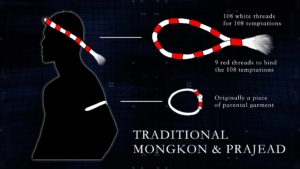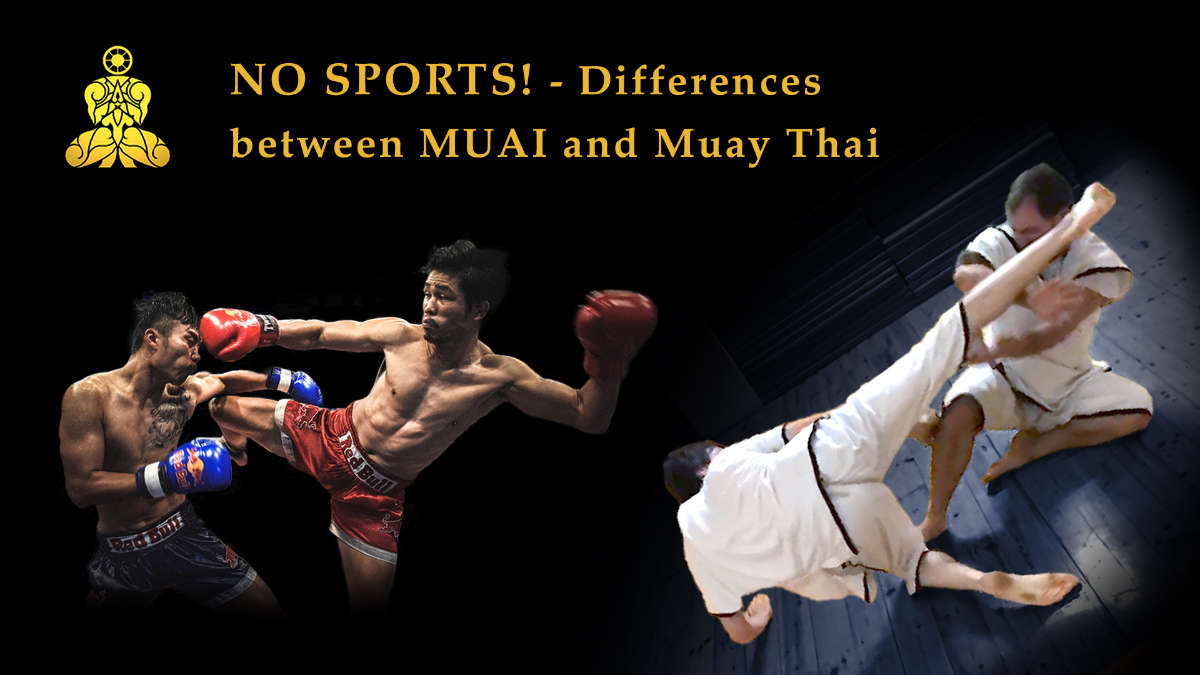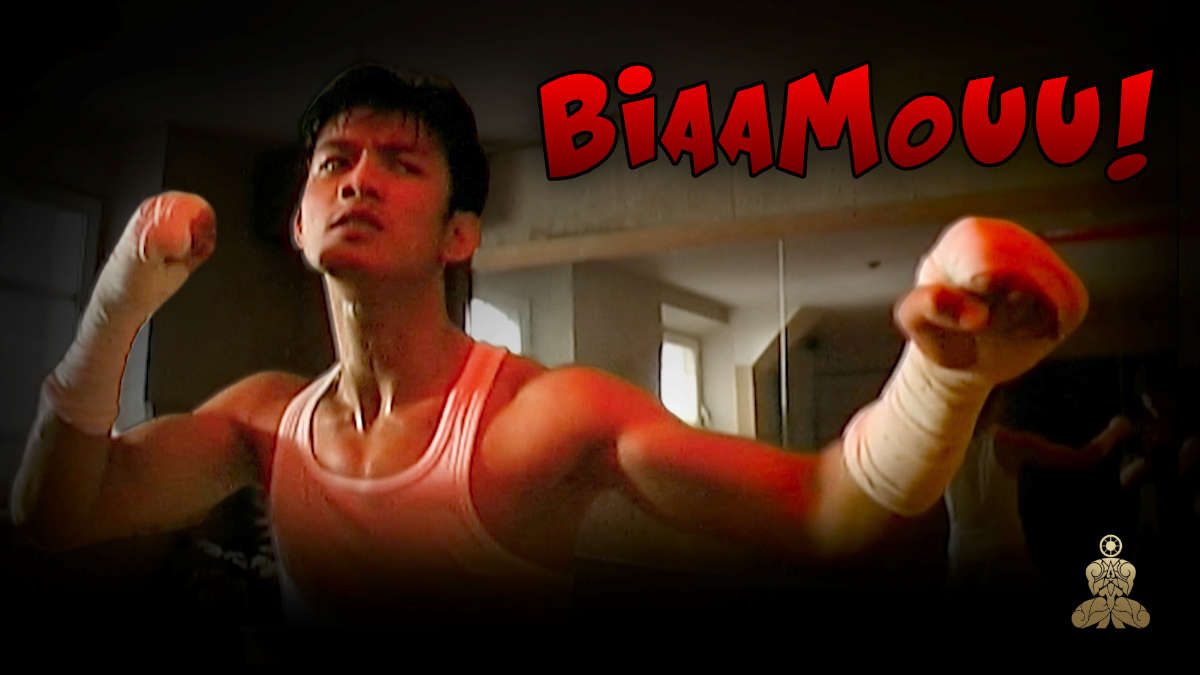What is a Mongkon?
A Mongkon (Thai: มงคล, also Mongkhon, Mongkol or Mong Kon) is a braided headband from Southeast Asia, which serves fighters as a talisman or patron saint.
Content
Origin
According to tradition, Mongkon originally consisted of one hundred and eight (108) magical white cotton threads (Day Dibb), which had been wrapped at nine points with red cotton threads. The length of the Mongkon was measured so that it roughly corresponded to the circumference of the head plus two fist widths.
The 108 white threads symbolized various possible types of danger from the prevailing belief, from which it was necessary to protect the fighter. In Hinduism, Buddhism and other Asian religions, 108 is a sacred number with deeper meanings. Buddhism, for example, counts 108 earthly temptations or longings of man. In the Thai language, the number 108 (Thai: ๑๐๘) again means an “indescribably large amount” of things.
The nine red cotton threads of the Mongon symbolized the souls of Gleeh Gauw Peehnong, the forefathers of Pahuyuth. Through their assistance, the dangers threatening the fighter should be suppressed or bound in order not to be able to penetrate or act on the bearer of the Mongkon. The original Mongkon served as a magical talisman for its wearers.
The production of Mongkons was done using certain rituals (see Magic object). It should be mentioned that the tradition of using magical objects (Kohng Klang), such as the Mongkon, originally did not originate from Thai Buddhism or Hinduism, but from Brahmanism or Saiyasart . Thai Buddhism adopted these practices, which is why amulets and talismans of all kinds can still be found in Thai culture today.
Further Development
Other forms of Mongkon emerged in later epochs. In times of war, young men were drafted as conscripts. At their farewell, they took torn strips of cloth from the lower parts of their parents’ clothing (Pha Nung, Sarong) and wore them as headbands or bracelets (see Prajead / Prajeat). According to the color of the clothes, these fabric bands were mostly blue, which symbolized the love and care for the child. This type of Mongkon was mainly worn by conscripted soldiers who were recruited from the villages and sent to war.
Alternative Theory
Another theory about the origin of the Mongkon goes back to the legend of Zaiyuh, in which the monk Tam Gam Jang attached a ring to the head of the ape-man in order to control him and at the same time protect him from external influences.
Chinese historians occasionally associate this magic ring with the Chinese headscarves of earlier eras. However, the tradition of wearing a headband is widespread almost everywhere in Central and Southeast Asia. A Chinese origin of the Mongkon can therefore not necessarily be assumed. It is more likely that the Mongkon has a Southeast Asian origin.
In modern times, especially Muay Thai fighters wear a mongkon during competitions, which is supposed to bring them luck and protect them from harm. Other types of Mongkon emerged from a departure from the original meaning as a talisman.
The Mongkon in Muay Thai
A mongkon is a type of headband used in Thai boxing (see Muay Vethie) to protect the fighter from damage. It is tied around the fighters head before a fight . Putting on the Mongkon is often done by a revered family member or the fighter’s teacher. Mongkon is an important part of the traditions and culture of Muay Thai.
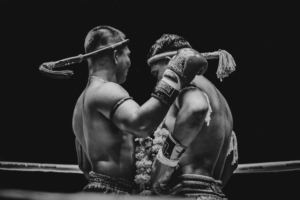
Mongkons are generally only worn in Thailand or at Muay Thai competitions. In other countries such as Cambodia or Burma, they are not used. The wearing of a Mongkon as well as the performance of a Wai Kru Ram Muay dance is usually prohibited in kickboxing.
Why do Muay Thai fighters wear a Mongkon?
The Mongkon is in the understanding of Muay Thai a sacred headband and thus a valuable talisman that should bring luck to the wearer in a fight by protecting him from injury. During the Wai Kruh Ram Muay (boxing dance), the Mongkon is worn by the fighter in the ring. After the Ram Muay and before the start of the first round, the fighter goes to his corner. The trainer (Kru) says a short prayer for his student and takes the mongkon from him. Now the fight can begin.

The importance of the Mongkon for the fighter:
Traditionally, fighters did not receive their mongkon from the trainer until they trained hard enough and were willing to honorably represent the boxing stable in the ring. The trainer had to be completely convinced of the student’s abilities.
Muay Thai fighters also wear the Mongkon out of respect for the trainer, the Muay Thai School, and the sport itself. In addition, it expresses gratitude and solidarity with all the people who accompanied the fighter on the difficult path to the fight. Thus, the Mongkon is a sign of loyalty, but also of subordination.
For a long time, women were denied the right to wear a Mongkon, as this was supposed to bring misfortune. Nowadays, however, many Muay Thai schools and trainers have deviated from these views and also allow their female students to wear a mongkon in the ring.
The right way to deal with the Mongkon:
Fighters wearing a mongkon should never get into the ring under the ring ropes or in between, but should always climb above it. Since the head is sacred as the highest part of the body in Thailand, climbing through the ropes would generally break the energy field. It is said that such disregard would bring misfortune. In addition, it is considered extremely disrespectful.
It should be mentioned that this practice mainly refers to male fighters. Even today female fighters in Thailand, are often told to crawl under the ropes, solely because of their gender.
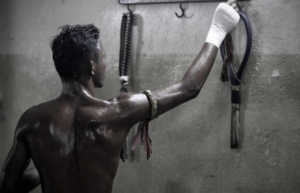
A Mongkon is a sacred object in the understanding of Muay Thai. It should always be worn and stored above the waistline, ideally at least at shoulder or head height. It should never get to the ground. If a Mongkon touches the ground, he allegedly loses its powers.
The consecration of the Mongkon:
The Mongkon is given the spiritual power that is said to be imputed to it by a special ceremony. The ceremony can be performed by both a Buddhist monk or a Muslim imam.
Muslim fighters (especially in southern Thailand and Malaysia) sometimes embed scrolls with Verses of the Koran in their Mongkon. With Thai Buddhist fighters, it is sometimes also common to weave bone fragments of a deceased ancestor of the fighter or the hair of a belocved person into the mongkon or additionally equip it with an amulet.
The consecration ceremony is usually attended by the trainers and the fighter himself. Such a ceremony alone often strengthens the self-confidence of the fighters, which in turn has a positive effect on the fight. Even fighters who do not live the teachings of Buddhism are allowed to participate in the ceremony and are protected by it according to unanimous doctrine.
Modern Mongkon production
The Mongkon as a graduation symbol
More recently, the idea arose to use prajeats and mongkons in different colors as graduation symbols (see Muay Boran). However, the use of a mongkon as a rank badge is an arbitrary departure from its traditional meaning as a talisman.
The background of such fads usually lies in the area of economic interests, because this establishes multi-level examination systems or hierarchies and thus money (e.g. examination fees) can be collected. The Free-Warriors of Pahuyuth explicitly distance themselves from such practices.
The Mongkon as a necklace
Another variation of the Mongkon is in the area of traditional costumes. Mongkons are introduced as necklaces or supposedly traditional costumes. The origin of this practice goes back to the wish that the teacher’s blessing may save the fighters head from being severed by the enemy’s sword.
In this regard, it should be noted that Southeast Asian swords, due to their nature and the way they are wielded, are not suitable for beheadings on the battlefield and that a rope sling that is deliberately worn around the neck poses an unnecessary security risk for a fighter. To use a Mongkon as a necklace is therefore conceivably unsuitable for real combat purposes.
What remains is the symbolic submission to one’s own teacher, which is thus promoted. However, this does not correspond to the original purpose of the Mongkon. The wearing of ropes on the upper body and neck in turn comes from Khmer slaves and is therefore not a real Thai tradition.

Recommended glossary entries

